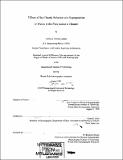Effects of the chaotic behavior of a superposition of waves in the flux across a channel
Author(s)
Trevino Lozano, Carlos H. (Carlos Horatio), 1971-
DownloadFull printable version (5.828Mb)
Other Contributors
Massachusetts Institute of Technology. Dept. of Earth, Atmospheric, and Planetary Sciences.
Advisor
Glenn R. Flierl.
Terms of use
Metadata
Show full item recordAbstract
Several numerical experiments were carried out to study the effects of chaotic behavior on the net tracer flux across a channel. The flow is given by a superposition of two propagating waves. The domain was set up so that a mode-I wave would fit on it, and the perturbation was a mode-4 wave. The experiments were carried out using a grid model with a second-order upwind differencing scheme. Simple Newtonian diffusion was used, and the velocities were calculated from a stream-function satisfying no normal flow boundary conditions. The experiments showed a small increase in the flux does appear due to the chaotic behavior, but this effect is only around 5% when the flux is compared to the one obtained from a pure 1-mode wave system. In contrast there is a difference of around 20% when the pure mode- 1 wave is compared to the pure mode-4 wave, the first one being more transportive. The chaotic behavior of the system is described in detail and a Lagrangian experiment was carried out as well to examine the motion of the particles and to explore a different approach to describing the dispersion of a tracer.
Description
S.M., Joint Program in Physical Oceanography (Massachusetts Institute of Technology, Department of Earth, Atmospheric, and Planetary Sciences; and the Woods Hole Oceanographic Institution), 1999 Includes bibliographical references (p. 59).
Date issued
1999Department
Massachusetts Institute of Technology. Department of Earth, Atmospheric, and Planetary SciencesPublisher
Massachusetts Institute of Technology
Keywords
Earth, Atmospheric, and Planetary Sciences.